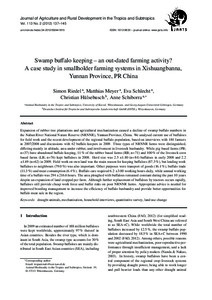Aufsatz

Swamp buffalo keeping – an out-dated farming activity? A case study in smallholder farming systems in Xishuangbanna, Yunnan Province, PR China
Zusammenfassung
Expansion of rubber tree plantations and agricultural mechanization caused a decline of swamp buffalo numbers in the Naban River National Nature Reserve (NRNNR), Yunnan Province, China. We analysed current use of buffaloes for field work and the recent development of the regional buffalo population, based on interviews with 184 farmers in 2007/2008 and discussions with 62 buffalo keepers in 2009. Three types of NRNNR farms were distinguished, differing mainly in altitude, area under rubber, and involvement in livestock husbandry. While pig based farms (PB; n=37) have abandoned buffalo keeping, 11% of the rubber based farms (RB; n=71) and 100% of the livestock-corn based farms (LB; n=76) kept buffaloes in 2008. Herd size was 2.5 +/-1.80 (n=84) buffaloes in early 2008 and 2.2 +/-1.69 (n=62) in 2009. Field work on own land was the main reason for keeping buffaloes (87.3 %), but lending work buffaloes to neighbours (79.0%) was also important. Other purposes were transport of goods (16.1%), buffalo trade (11.3%) and meat consumption (6.4%). Buffalo care required 6.2 +/-3.00 working hours daily, while annual working time of a buffalo was 294 +/-216.6 hours. The area ploughed with buffaloes remained constant during the past 10 years despite an expansion of land cropped per farm. Although further replacement of buffaloes by tractors occurs rapidly, buffaloes still provide cheap work force and buffer risks on poor NRNNR farms. Appropriate advice is needed for improved breeding management to increase the efficiency of buffalo husbandry and provide better opportunities for buffalo meat sale in the region.
Zitierform
In: Journal of Agriculture and Rural Development in the Tropics and Subtropics. Kassel : Kassel University Press. - Vol. 113, No. 2 (2012), S. 137-145Sammlung(en)
Vol 113, No 2 (2012) (Journal of Agriculture and Rural Development in the Tropics and Subtropics (JARTS))Zitieren
@article{urn:nbn:de:hebis:34-2012092441815,
author={Riedel, Simon and Meyer, Matthias and Schlecht, Eva and Hülsebusch, Christian and Schiborra, Anne},
title={Swamp buffalo keeping – an out-dated farming activity? A case study in smallholder farming systems in Xishuangbanna, Yunnan Province, PR China},
year={2012}
}
0500 Oax 0501 Text $btxt$2rdacontent 0502 Computermedien $bc$2rdacarrier 1100 2012$n2012 1500 1/eng 2050 ##0##urn:nbn:de:hebis:34-2012092441815 3000 Riedel, Simon 3010 Meyer, Matthias 3010 Schlecht, Eva 3010 Hülsebusch, Christian 3010 Schiborra, Anne 4000 Swamp buffalo keeping – an out-dated farming activity? A case study in smallholder farming systems in Xishuangbanna, Yunnan Province, PR China / Riedel, Simon 4030 4060 Online-Ressource 4085 ##0##=u http://nbn-resolving.de/urn:nbn:de:hebis:34-2012092441815=x R 4204 \$dAufsatz 4170 7136 ##0##urn:nbn:de:hebis:34-2012092441815
<resource xsi:schemaLocation="http://datacite.org/schema/kernel-2.2 http://schema.datacite.org/meta/kernel-2.2/metadata.xsd"> 2013-03-05T13:18:27Z 2013-03-05T13:18:27Z 2012 1612-9830 urn:nbn:de:hebis:34-2012092441815 http://hdl.handle.net/123456789/2012092441815 eng Kassel University Press Urheberrechtlich geschützt https://rightsstatements.org/page/InC/1.0/ draught animals mechanisation household interviews quantitative survey land use change 630 Swamp buffalo keeping – an out-dated farming activity? A case study in smallholder farming systems in Xishuangbanna, Yunnan Province, PR China Aufsatz Expansion of rubber tree plantations and agricultural mechanization caused a decline of swamp buffalo numbers in the Naban River National Nature Reserve (NRNNR), Yunnan Province, China. We analysed current use of buffaloes for field work and the recent development of the regional buffalo population, based on interviews with 184 farmers in 2007/2008 and discussions with 62 buffalo keepers in 2009. Three types of NRNNR farms were distinguished, differing mainly in altitude, area under rubber, and involvement in livestock husbandry. While pig based farms (PB; n=37) have abandoned buffalo keeping, 11% of the rubber based farms (RB; n=71) and 100% of the livestock-corn based farms (LB; n=76) kept buffaloes in 2008. Herd size was 2.5 +/-1.80 (n=84) buffaloes in early 2008 and 2.2 +/-1.69 (n=62) in 2009. Field work on own land was the main reason for keeping buffaloes (87.3 %), but lending work buffaloes to neighbours (79.0%) was also important. Other purposes were transport of goods (16.1%), buffalo trade (11.3%) and meat consumption (6.4%). Buffalo care required 6.2 +/-3.00 working hours daily, while annual working time of a buffalo was 294 +/-216.6 hours. The area ploughed with buffaloes remained constant during the past 10 years despite an expansion of land cropped per farm. Although further replacement of buffaloes by tractors occurs rapidly, buffaloes still provide cheap work force and buffer risks on poor NRNNR farms. Appropriate advice is needed for improved breeding management to increase the efficiency of buffalo husbandry and provide better opportunities for buffalo meat sale in the region. open access In: Journal of Agriculture and Rural Development in the Tropics and Subtropics. Kassel : Kassel University Press. - Vol. 113, No. 2 (2012), S. 137-145 Riedel, Simon Meyer, Matthias Schlecht, Eva Hülsebusch, Christian Schiborra, Anne Gedruckte Ausg. im Verlag Kassel Univ. Press (www.upress.uni-kassel.de) erschienen. </resource>
Die folgenden Lizenzbestimmungen sind mit dieser Ressource verbunden:
Urheberrechtlich geschützt

